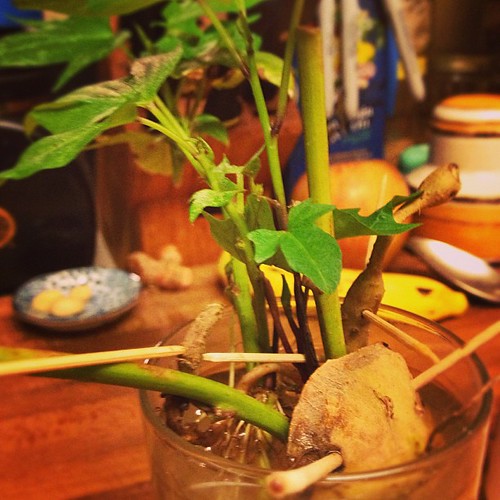Post by macmex on Dec 21, 2020 16:45:29 GMT
Apart from obtaining stock or planting, the most basic facet of raising your own sweet potatoes is starting slips (a slip is a cutting). I can think of three different ways to start slips. Which method you choose will probably depend on how many slips you want to produce.
This most commonly used method (at least what one hears about the most) is to simply stick a sweet potato root in water and let it sprout.

"Purple sweet potato slips" by macguys is licensed under CC BY-SA 2.0
This works fine for smaller quantities of slips. Many old timers remember having a sweet potato plant in the kitchen window during the winter months. They'd snip some slips in the spring and start their sweet potatoes that way. The disadvantages of this method are: 1) This method gets unwieldy when one wants more than a few dozen slips, and 2) It gets even more unwieldy if one is starting a quantity of various varieties of sweet potatoes. It seems to me that having no nutrition in the water would be a disadvantage, but honestly, I've never heard anyone who uses this method say that it caused them any concern.
Another method is to start slips in flats of soil mix.

One lays the roots on a layer of soil and then fills in until they are nearly covered. In the picture above you can see that the roots are not completely covered. I don't think it makes much difference if they are or not, though the soil mix tends to settle and expose the roots with time. Sometimes I add more. Flats can produce more slips than a slip in water. They do take up some space. One can move flats around, which can be handy if cold temperatures threaten. I usually start my flats on our sun porch and, our fickle Oklahoma weather can hit us with really cold temps before warm weather sets in. When it does, I bring them into the house.
I usually grow only one variety in a tray, as it helps to avoid mixing them up at planting time. Starting slips for about a dozen varieties makes for a lot of flats!
A disadvantage of using this method is that moving the flats around can be quite laborious. Also, one needs to have enough light for the slips. You can start slips without light, but once they start growing, they need the equivalent of full sun.
A third way of starting slips is to start them right in the ground.
I had a mentor who started hundreds of slips in a cold frame. It worked very well.
Here's a photo of a cold frame, constructed with surplus windows.

"planting a homemade cold frame" by woodleywonderworks is licensed under CC BY 2.0
One can produce A LOT of slips this way. Of course it would be important to keep varieties straight and not mix them up. Also, a cold frame won't protect against truly frigid weather, so don't start too early in them
Almost every year I'll have greater demand for a variety than I started in my trays. I'll end up digging a trench, somewhere in the garden, and laying roots of that variety in the trench. I can only do this when weather has become truly warm. It's amazing to see how quickly they sprout and produce an abundance of slips. Many is the time that I end up using those for my own garden, as sales strip me of all that I started in flats. (Customers generally want their slips early, earlier than perhaps they should.)
I've heard of digging deeply and laying a thick layer of fresh manure or some other hot material, then placing about half a foot of soil over top of that before planting sweet potato roots over top of it all. The decomposing material produces heat which supposedly heats the cold frame above. It should work.One would want to be sure that the growing roots don't come in direct contact with the hot organic material, as it could be too rich for them. In my opinion this would be a lot of work to construct, but I think it would work. If you do this, let me know how it works for you.
Anyone else have a method they use for starting slips? We want beginners to succeed!

